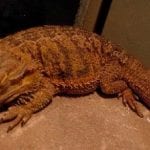Scientific Facts
| Common Name | African Clawed Frog, Xenopus, Platanna, African Claw-Toed Frog |
| Scientific Name | Xenopus laevis |
| Life Span | 12 to 30 years, in captivity |
| Mass / Size | Males: 2 ounces Females: 7 ounces |
| Length | Males: 2 to 2.5 inches Females: 4 to 4.5 inches |
| Habitat | Rivers, ponds, and stagnant waters |
| Country of Origin | Sub-Saharan Africa – Nigeria, South Africa, and Sudan |
Naming / Taxonomy
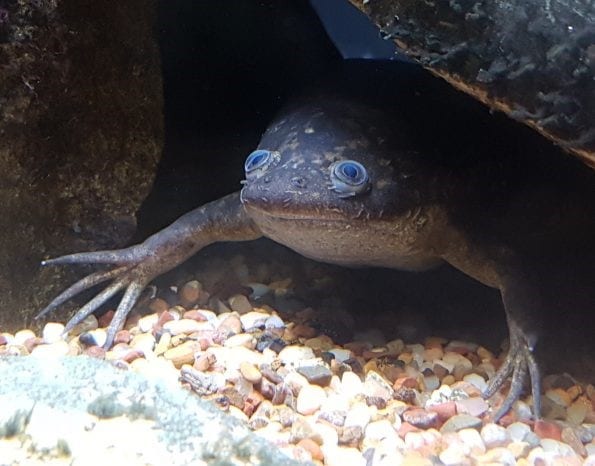
Xenopus laevis is the scientific name of the African clawed frog. Distinguished by the appearances of its foot, the African clawed frog got its namesake from this characteristic. Basically, Xenopus translates to mean “strange foot.” On the other hand, the Latin word Laevis means “smooth.” This frog belongs to the Pipidae family of aquatic toads, and its unique survival trait aids it for eating their pray: these are the three claws on its two back feet. People usually call them platanna, African claw toed frog, Xenopus, or the African clawed toad.
Physical Description
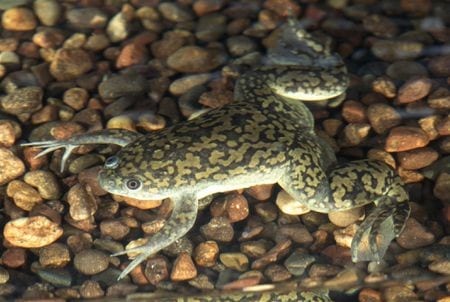
African clawed frogs belong to the Pipidae family. All members of this group of frogs have unique characteristics. You can mainly recognize them through two things: first, their ears are not visible; and second, they do not have a tongue. These frogs are not able to move their eyelids around. Only a transparent membrane serves as their eyes’ protection. Vocal cords are also missing from the males.
This toad has a flat body with a head shaped like a wedge. It is encased inside a camouflage-colored skin that serves as its defense mechanism. Its nostrils and eyes are located on top of its head. This placement helps them see and breathe even while they are submerged or hidden. As said by its name, the skin of the African clawed frog is smooth and colored with a blend of green, brown, and gray, including a mix of yellow and white tones on its belly.
When moving on land, this clawed frog only crawls and has trouble walking. But when they are on the water, they are tremendous and agile in swimming. They use their front limbs to grasp their food and eat it. For its legs, the pair at front are tinier compared to the couple at the back. The other two at the end are the clawed ones this toad is famous for.
Conservation Status
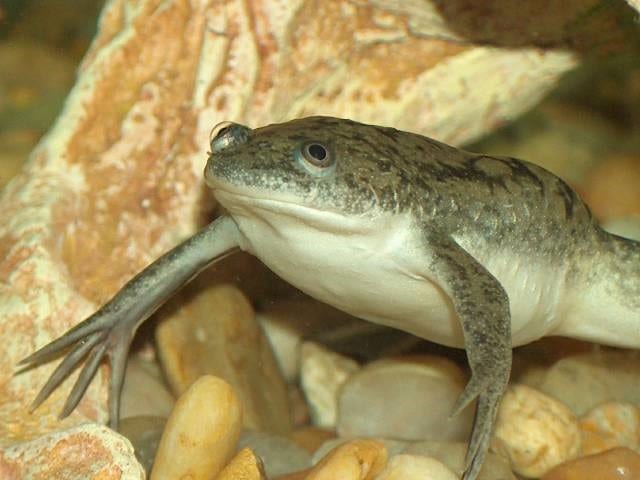
In the succeeding years to come, the African clawed frog has no need to fear to be endangered and extinct. Their species are widely distributed with large populations all over the world. Aside from being kept as pets, the African clawed frog has been used for the benefits of science and is utilized in research and laboratory testing all over the world.
To help conserve this species, make sure that you choose your pet wisely, and only adopt one if you are sure that you are capable of taking care of them.
Life Span
In the wild, African clawed frogs are observed to live about 5 to 15 years. But, when they are under human care, they can reach up to 30 years of age.
Availability and Natural Habitat
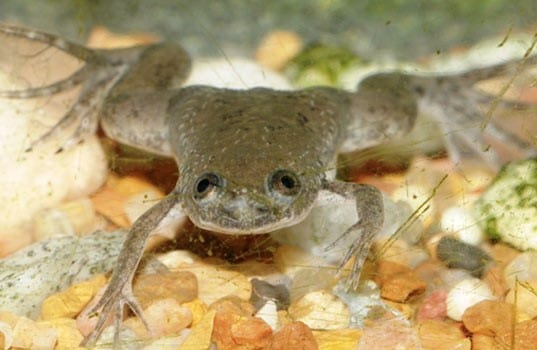
The African clawed frog is known to originate in Africa. Most of these toads can be found living near some bodies of water in Angola, the African Rift Valley, Namibia, and South Africa. Most of the Xenopolus frogs choose to stay in stagnant water areas and peaceful streams where the temperature is warmer. They prefer staying long-term in the ponds compared to living on land. When their current home base encounters some problems, they just migrate to another attractive water area.
Nowadays, they can also be found in countries like Chile, France, Italy, Indonesia, Portugal, the United Kingdom, and the United States. Because of overpopulation, some of these territories treat them as pests.
Behavior
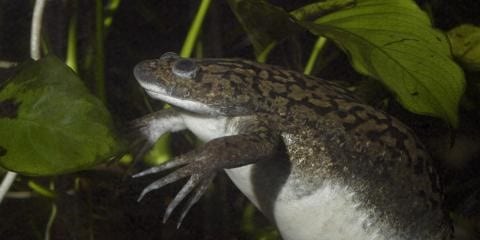
African clawed frogs enjoy spending their time swimming. They are so good that they can even swim backward, forwards, sidewards, and other directions. They love the water so much that they spend all their time submerged under it with occasional floating just to breathe in oxygen.
These toads are famous for being able to survive extreme environmental conditions, which makes them practical predators. The African clawed frog can travel to find different ponds or lakes to live when its old one gets compromised. They like invading bodies of water and disrupt peaceful ecosystems. These African clawed frogs have also been recorded to eat all of the young and wipe out populations of other aquatic animals, amphibians, and reptiles in the wild.
The African clawed frog is equipped with self-defense methods so that they can survive. They have quick impulses that allow them to reverse their actions immediately. They can also secrete some toxins that can harm their predators, even some snakes. Aside from this, some compounds are also secreted by their skin that has unique antiviral, antiparasitic, antifungal, and antibiotic properties, which prohibit them from contracting some infections.
Ecological Threats and Infestations
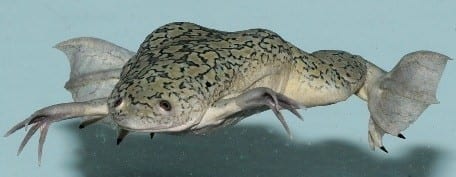
The African clawed frog has brought ecological imbalance in many communities. For instance, the Golden Gate Park in San Francisco is now struggling with the continuously increasing population of African clawed frogs. Though authorities are unsure if this was intentional or a frog escaped somewhere, the community is seeking the extermination of these toads. The local government has actually decided to drain all the water in the pond with the hopes that the frogs will die a natural death.
Reports of large groups of African clawed frogs in South Africa has led to clogging up irrigation pipes, fish farm invasions, and invading random houses. On the other hand, some species of these frogs were proven to significantly decrease the populations of Buro boreas, commonly known as the Western Toad.
Because of problematic cases like what they experienced, it is now illegal to have possession, transportation, and distribution of the African clawed frog in the US states of Washington, Nevada, Virginia, Hawaii, Vermont, North Carolina, New Jersey, Ohio, Louisiana, California, Kentucky, and Arizona.
Diet
One good reason why African clawed frogs are considered as great pets is that they can eat a large variety of food, whether living or dead. For clawed toads in captivity, you can opt to feed them with some nutritional sticks. They are created to provide a well-balanced meal, but your pet can benefit from enjoying a tasty variety from time to time.
For some live feeds, you can give your pet some brine shrimp, bloodworms, earthworms, feeder fish, and wax worms. If you are feeling adventurous, opting for cat food and dog food can be done as well.
As pet care is continually evolving, some customized clawed frog pet food can be bought from the reptile and amphibian research laboratories and specialized exotic pet stores. Make sure that you feed your pet toad with a balanced meal every day. If this is something that might cause difficulties, you can opt for buying some supplements that will ensure your pet’s safety.
Eating Habits
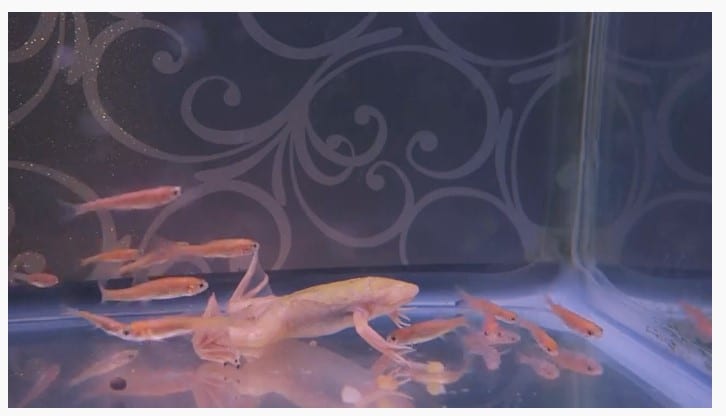
When living in the wild, the African clawed frogs are great hunters. They scavenge all types of food, whether alive, dying, or already dead. Their food choices can vary from the larvae of other insects, larvae, some organic waste, crustaceans, snails, worms, small fishes, and other tadpoles. You can be surprised by how much food these toads can take and how intense their appetites can be.
These intense attackers have a line system, a great sense of smell, and fingers with sensitive skin, that aids them in finding food. Their body is equipped with a sucking mechanism that helps them in the absence of their tongue. Plus, their famous claws allow them to rummage their food and cut it into tinier pieces.
When placed in captivity, the African clawed frogs can be trained to take their meal when handed over by their owners politely. These frogs are not equipped with teeth, so there’s no need to worry about getting bitten.
You need to watch out for overfeeding, though. When your African clawed frog is getting fed every day, you should try monitoring its body shape. When you see your pet getting too fat and gaining weight, you can fix the schedule that you use, so your frog will not get overweight.
Development and Reproduction
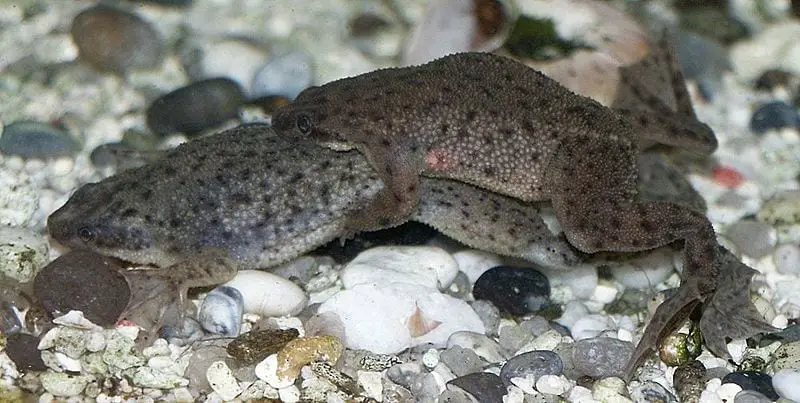
Once African clawed frogs reach a year old, they become sexually matured and ready for reproduction. These toads usually do their coupling in the evenings, when it’s dark out. In mating, they assume the position called amplexus, which basically means that the females get grabbed from behind, around her pelvis, by her partner. As a result, the female frog will give birth to a couple hundred up to two thousand eggs. These eggs are covered with a jelly-like sticky membrane that would mean they can get stuck on some stones, barks, and branches underwater.
It will only take the eggs about five to seven days to transform into tadpoles. These little tadpoles will live underwater and look as small as 20 millimeters. After six weeks, these tadpoles will develop and become adult frogs. If you look at this carefully, both the mother and father frogs do not express any form of parental instincts and care.
Mating Season
African Clawed Frogs traditionally begin their mating season during the springs and the summers. But, these events can happen at any time of the year. For the most part, these things depend on where your frogs are geographically located. African clawed frogs are also very active, so this can happen about three to four times within a year.
Common Health Problems
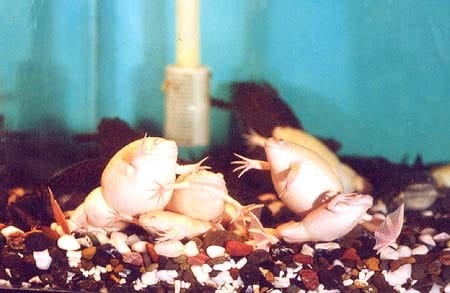
Taking care of African clawed frogs involves watching out for their health. They can also contract fungal and bacterial infections which is a stress to their wellbeing. To check if your pet toad suffers from this, investigate if there is discoloration on their eyes and there is a white cotton-like fungus gathering on their body.
African clawed frogs can also suffer from bloating disease. This disease exhibits when the chin, legs, and abdomen of the frog expands like a latex rubber glove being blown up. When your frog contracts this illness, it may lose interest in eating and have a hard time submerging in the water because it keeps on floating. When you see significant changes in the appearance of your African clawed frog, head on straight to your trusted vet.
If your frog’s immune system is compromised, it might be also be exposed to Tuberculosis. Mycobacterium ranae, marinum, or xenopi can induce this illness to your pet frog by entering through open sores and wounds. This illness is very contagious to other amphibians so you should hurry and bring your pet to a licensed vet.
Additionally, you should be concerned with red leg disease, which is typical for frogs in captivity. You can identify red leg disease from a sudden redness in your frog’s limbs. This is caused by the presence of bacterial parasite that your African clawed frog can encounter through the air, water, or food in its enclosure. If you suspect that your African clawed frog is suffering from this problem, you should book an appointment to your trusted exotic amphibian veterinarian right away.
Preventing Illnesses
As an African clawed frog owner, all you seek is to make sure there are of optimum health conditions. To achieve that, here are some things you should note.
First, make sure that you get healthy pets, to begin with. When you purchase your frog, avoid those showing signs of illness and pick a healthy one. Look at the skin and beware of fungus growth. Check that they have their complete set of limbs with no injuries and that they have clear, bright eyes. Because they enjoy being in groups, buying a pair or more would make sure your pet won’t feel lonely.
Next, you should monitor the diet of your pet toad. The clawed frog must be fed high-quality food with traces of vitamins and calcium. Live insects and worms are high, but rotating them with other types of frog food can be great, too.
Don’t forget that the surroundings of your clawed frog must be well-maintained. Regular cleaning can go a long way in avoiding all sorts of contaminants to get in contact with your pet.
How to Care African Clawed Frog as a Pet?
Handling
Handling is not really something preferred by aquatic frogs. Though you are their pet owner, African clawed frogs would much rather remain swimming inside their water enclosure instead of spending time held by you. If you want, though, you can train your clawed frog to eat food that you have placed in your palm without injuring you. Aside from this, it would be best to limit your handling to transferring them in a temporary location every time you clean their aquarium.
Caging
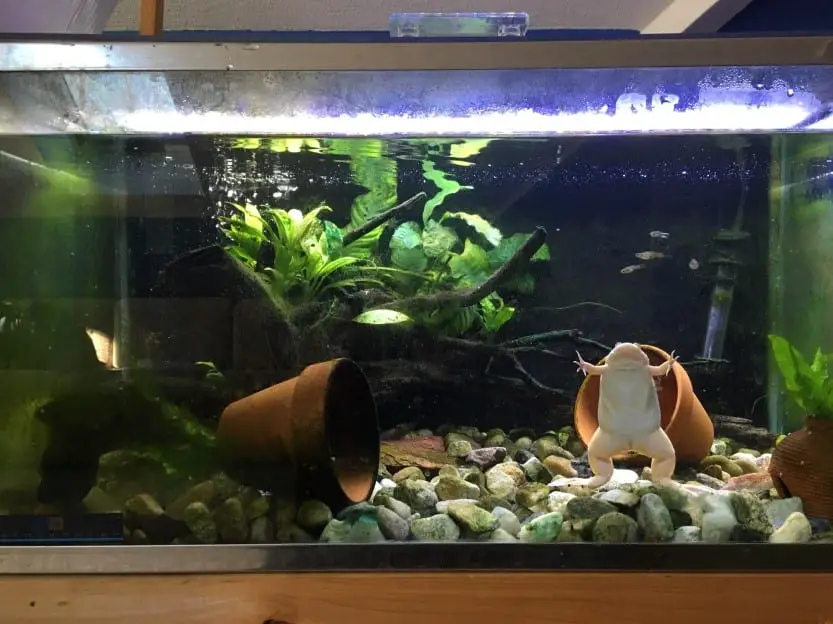
An ideal aquarium for your pet African clawed frog will be dependent on how big it is. Usually, keepers go for one with a 10-gallon capacity. This size would be spacious enough for your amphibian to enjoy some daily activities.
For the aquarium, you should make sure that the water will be about one foot deep. This is enough for them to swim around, but can also give them the freedom to go above ground and on land when they wish to. Though they prefer to be on the water, these frogs still need to go up and breathe in the oxygen supply that they need. If 12 inches seems too hard for you to acquire, at least half of that can be enough for your pet toad to move around.
Additionally, you have to make sure that the cage that you buy will come with a tight and secure cover. These frogs can leap high enough and escape to the wild when you don’t watch out to keep them in. Some places with an overpopulation of African Clawed Frogs see this escapism as one of the main reasons why their populations become above the ideal number.
Before you transfer the frog to its new home, you should leave the vacant aquarium for a few hours, so that everything will be able to settle down and the water will be regulated to match the temperature of the room. Then, place your frog inside a plastic bag filled with water. Drop the bag gently inside the aquarium and allow your frog to get used to the temperature level in the tank. After a few minutes or so, release your frog from the plastic bag and let it become acquainted with its home.
Substrate
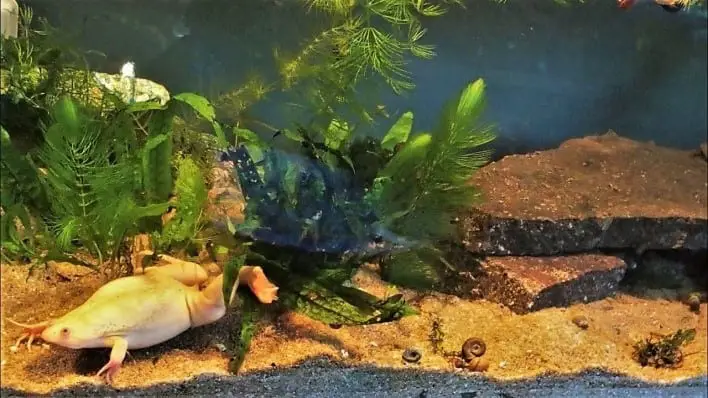
To line the bottom of your frog’s aquarium, you can purchase some gravel and use them as substrates. Just make sure that the gravel you are buying will be big enough and will not be eaten by your pet. As a substitute for gravel, you can also use bathroom tiles, marine sand, river rocks, and pieces of slate as the aquarium tank’s substrates.
For decorating your space, try to mimic their natural habitat as much as you can. Flowers, plants pots, branches, logs, barks, and other rocks can provide a similar aesthetic, and it also can be your frog’s hiding room.
If you observe your African clawed frog eating the live plants you see in the aquarium, you can just opt for buying fake and plastic ones.
Water
Amphibian care experts and some keepers debate over using some water filters in the living space of your frog. Remember, the African clawed frog does not have ears, so there body is equipped with a lateral sensory line to detect the movements in the water. For them, vibrations of a water filter can be too loud and cause them much stress.
Even though you seek to keep your tank’s water clean, you should not involve chlorine in your cleaning procedure. There are some products you can get which can remove chloramine and chlorine content that you can buy from pet shops, or you can treat water and allow the chlorine to evaporate for around 24 hours. If those things are unavailable to you, you can go for using bottled water. Because minerals and salts are infused in these drinks, this can be the safest method that is supported by most amphibian keepers.
Your best option for an African Clawed Frog’s water needs would be to use a gentle and delicate water filtration system. This can keep maintaining the cleanliness of the aquarium while avoiding stressing your pet. While in the wild, African clawed frogs can stay in unmoving water, but you can’t do that in captivity. Stagnant water can accumulate bacteria and dirt, which can cause contamination and can cause significant health risks.
Lighting and Temperature
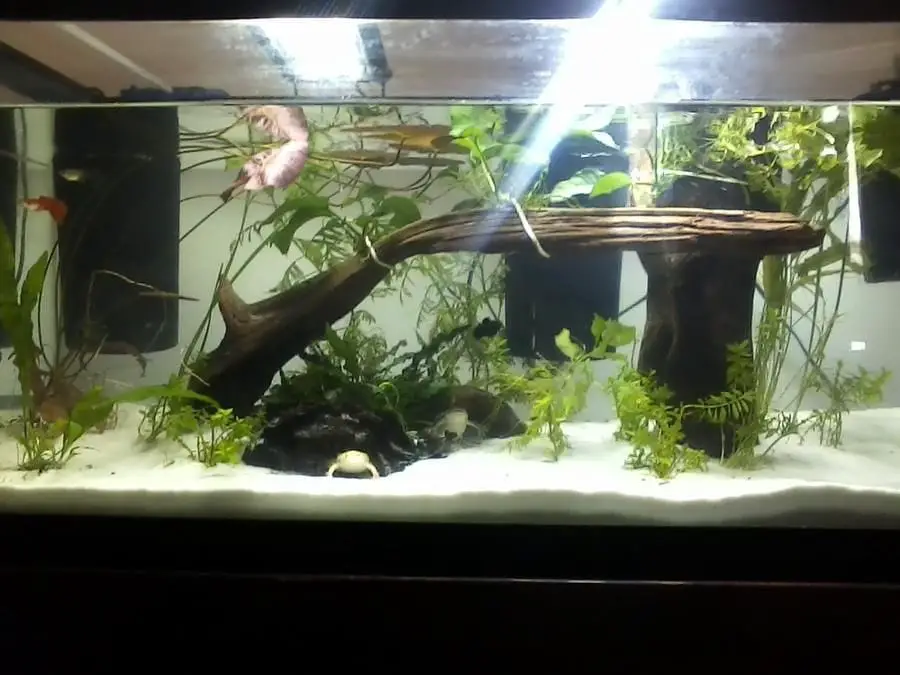
In terms of light, African clawed frogs require low maintenance and do not need unique and special bulbs just for them to be healthy. For the temperature requirements, make sure that you maintain 68 degrees to 75 degrees Fahrenheit room temperature. If you want to be able to see your frog and maintain a lighting schedule, you can use a standard aquarium bulb, or you can apply some indirect bulbs. If you can, dividing day and night for twelve hours lighting each can establish a daily schedule for your pet.
Fun Facts about African Clawed Frog
- The male African Clawed Frogs have a unique mating call, where they use the muscles in their larynx to produce trills.
- The African clawed frogs have served an essential role in scientific research. In facts, it was one of the first animals studied and cloned.
- The African clawed frogs have also contributed to the advancement of cellular and molecular biology, neurobiology, developmental biology, and toxicology.
- If the body of water that serves as its home suffers from drought, a deep burrow in mud can serve as the hiding place of this frog while hibernating as long as 12 months.
- If an African clawed frog encountered an accident and lost one of their limbs, there is a chance for it to grow back.
- The African Clawed Frogs were used to test if a human is pregnant during the 1930s.
- Some cultures in the Sahara eat the African Clawed Frog with the belief that they can be used as fertility medicine and aphrodisiacs.
- One of the most significant protections of the African clawed frog against their ever-changing environment is a wound-healing antibiotic that is always present in their skin.
- The African clawed frog does not have a tongue, teeth, and ears.
- These frogs eat their own skin when they undergo shedding during the change of seasons.
Where Can You Get an African Clawed Frog?
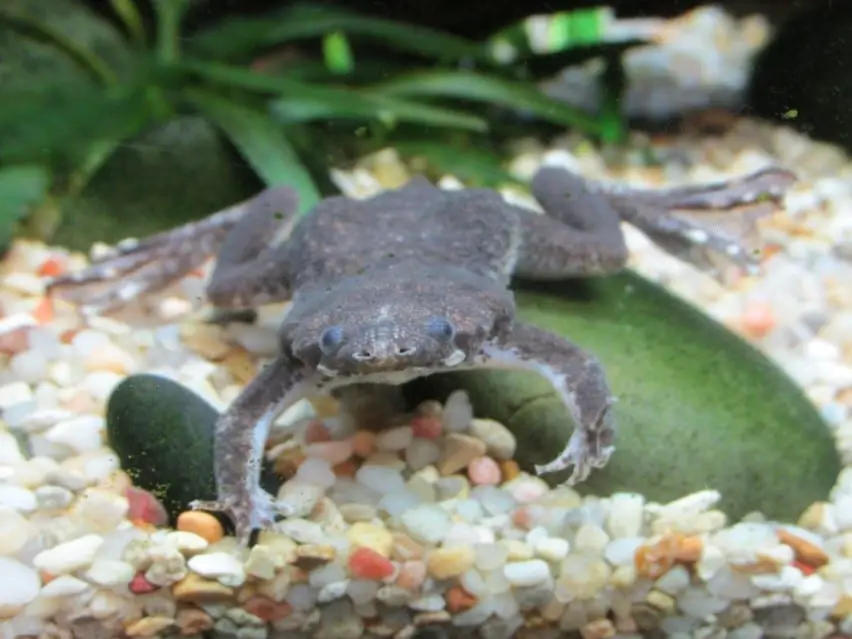
African Clawed Frogs are one of the most famous exotic animals to keep as pets. Your best option to get one is to buy from a legitimate breeder that has an excellent reputation in the community. Make sure to get one that is captive-bred, which means it can adapt quickly to your environment. This will also help ensure that you can get a frog that is sickly, lethargic, or infected with viruses.
FAQs
Why are African clawed frogs illegal to own in my area?
Some states prohibit having African clawed frogs as pets because they can be very invasive when they escape, and they can disrupt the peace in many bodies of water and ecological systems.
Are African clawed frogs poisonous?
These frogs can secrete toxic chemicals when they feel threatened. This can be fatal to fish and other small animals and can induce skin irritations for humans.
Are African clawed frogs aggressive?
When they are hungry and hunting for prey, African clawed frogs exhibit aggressive behaviors and immediately attack their targets.
Are African clawed frogs blind?
The clawed frog has working eyesight, but it is not as used as it should be. When hunting and seeking for food, the African clawed frogs tend to trust their sense of scent more.
Can I hold my African clawed frog?
African clawed frogs are aquatic beings and prefer to be in the water. Yes, you can hold them, but they do not really prefer this compared to swimming around their tank.
Can I put fishes in the tank of my African clawed frog?
Not really. African clawed frogs are wild predators, so the fish that you place inside the tank will be attacked and treated as food.
Does the African clawed frog sleep?
Yes, the clawed frogs prefer sleeping during the day. You will usually spot them sleeping in the corner of their enclosure or their favorite hiding place.
Are African clawed frogs cannibals?
Yes. The African clawed frog eats almost all the species it encounters. They even eat the eggs that they have given birth to, young tadpoles, and tiny froglets of the same species.
Can I feed my African clawed frog some snails?
Yes, snails are included in the usual African clawed frog diet.
Does an African clawed frog hibernate?
Yes. If the usual habitat is not available to the clawed frogs, they find a muddy area where they can hibernate and not eat anything and stay dormant for about eight months.

